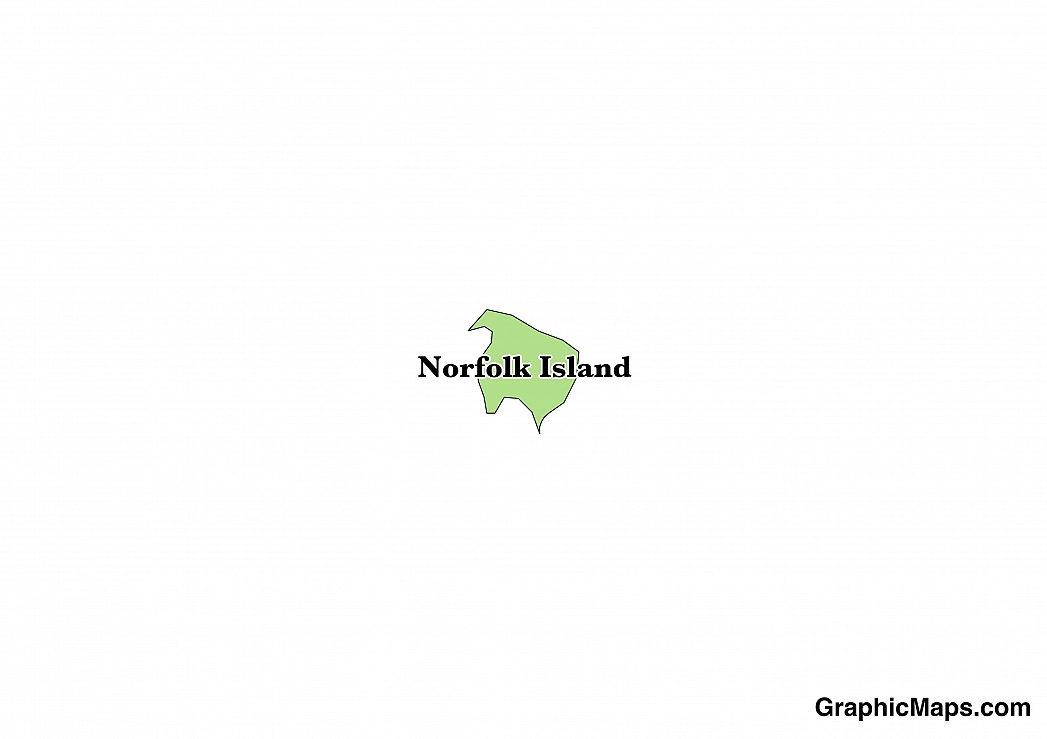Where is Norfolk Island?
Located in Oceania, Norfolk Island is an island nation. It has a 32.00 km coastline.
The capital city of Norfolk Island is Kingston, located in the southeastern part of the country. The town was founded by British settlers in 1788 who had sailed from Port Jackson in New South Wales, Australia. Initially, the town of Kingston was known as Sydney Bay and was named Town of Sydney in 1796. Between 1825 and 1855, 1,200 Australian convicts were used to construct the some of the buildings in the city that remain today. The climate of Kingston is classified as a subtropical oceanic environment with mild, spring-like weather for the majority of the year. During the warmest part of the year (January and February), the daytime temperature usually averages 25 degrees Celsius (77 degrees Fahrenheit) and falls to 20 degrees Celsius (68 degrees Fahrenheit) during the night. During the cooler months of July and August, high temperatures average around 18 degrees Celsius (64 degrees Fahrenheit) and lows that are approximately 13 degrees Celsius (55 degrees Fahrenheit). The setting of Kingston provides for a multitude of beach activities such as swimming, snorkelling, and fishing in Emily or Slaughter Bay. This little city is a gem in the South Pacific Ocean.
Read more on Norfolk Island's CapitalNorfolk Island is an Oceanian country covering 36.00 km2. and about 0.2 times the size of Washington, DC. Its geographic coordinates are 29 02 S, 167 57 E and Kingston is the capital city.
Its ISO code is NF.
Geography
Norfolk Island has a mean elevation of 0 m above sea level.
It has a subtropical climate with little seasonal temperature variation. Its terrain is mostly volcanic with some rolling plains.
Population
Norfolk Island has a population of 2,210 making it the 231st largest in the world.
English is the official language, Norfuk is also widely spoken. The major ethnic groups reported are Australian and New Zealander. The majority of the country is Protestant Christian or Roman Catholic.
There are two official languages in Norfolk Island, and they are English and Norfuk. English is a common language due to the past influence of the United Kingdom and Australia, who have both administered the country. In 2007, Norfuk was added to the list of endangered languages by the United Nations. Norfuk is a blend of 18th-century English and Tahitian and is also known as an English Creole.
Read more on Norfolk Island's LanguagesThe dialing code for the country is 672.
Government
It is a territory of Australia. Its constitution was last ratified in 1914.
Norfolk Island is administered by a local council with government services to the island provided by the Australian state of New South Wales. Norfolk Island was previously a self-governing external Australian territory, but due to financial struggles and never gaining self-sufficiency, the government of Australia revoked the island's right to self-governance in 2015. While under self-governance, Norfolk Island had a legislative body, known as the Norfolk Legislative Assembly, from 1979-2015. The first members of this legislative body were elected during national elections on 10 August 1979. The last assembly of the Norfolk Legislative Assembly took place on 13 March 2013 and was subsequently abolished by the Australian government in June of 2015. The transition to a Norfolk Island Regional Council began shortly after and this council was established on 1 July 2016. This headquarters of this council is located in the capital city of Kingston. Australian national elections take place every three years, and the most recent took place in July of 2016. Elections for state and regional representation take place every four years, and in many states, these dates are fixed by legislation. The country has had a long history of fairly contested and transparent elections and is considered one of the model democratic countries in the world.
Read more on Norfolk Island's GovernmentEconomy
The currency of Norfolk Island is the Dollar (AUD).
Flag
The flag of Norfolk Island consists of three vertical stripes of green-white-green, the central field is slightly larger than the outer two. The ratio of the three stripes is 7:9:7. The Norfolk Island Pine (Araucaria heterophylla) is depicted in green in the central white field and takes up the majority of this area. This flag was adopted on 6 June 1979 and became official in 1980. Although the original designer of this flag was never formally announced, this banner was chosen by the Norfolk Island Council as the new flag of the nation in 1979. This council was elected by citizens of the country once Australia had granted the nation limited self-governance. To this day, the individual who designed this flag is not known publicly. European settlement of Norfolk Island began in 1788, and the British Flag was raised on the island. After abandoning the island, British settlers once again reached Norfolk Island to establish a penal colony in 1825. The territory was eventually given to Australia from the United Kingdom in 1913, and the small island flew the flag of Australia until 1979.
Read more on Norfolk Island's FlagThis page was last modified on February 6th, 2018
More on Graphicmaps

Published on 2019-11-06
What is a Trade Embargo?

Published on 2019-11-04
Which Two Countries Used to Have the Same Flag?

Published on 2019-09-16
What Is the Only Two-Sided State Flag?

Published on 2019-09-16
Which Country Flag Looks Like the Texas Flag?

Published on 2019-08-29
Flags That Resemble the US Flag

Published on 2019-08-20
